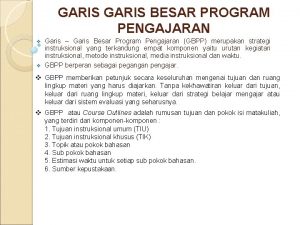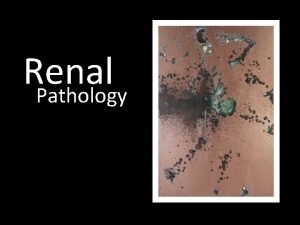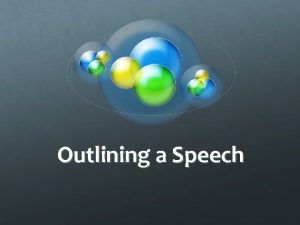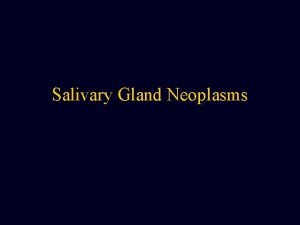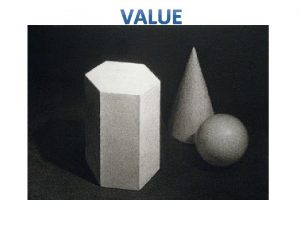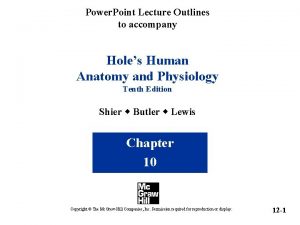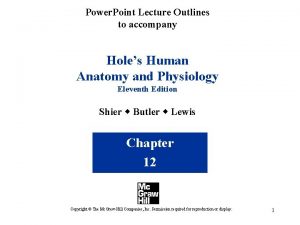Power Point Lecture Outlines to accompany Holes Human































- Slides: 31

Power. Point Lecture Outlines to accompany Hole’s Human Anatomy and Physiology Eleventh Edition Shier w Butler w Lewis Chapter 6 Modified by: Amber Jackson Copyright © The Mc. Graw-Hill Companies, Inc. Permission required for reproduction or display. 1

Chapter 6 Skin and the Integumentary System • Composed of several tissues • Maintains homeostasis • Protective covering • Retards water loss • Regulates body temperature • Houses sensory receptors • Contains immune system cells • Synthesizes chemicals • Excretes small amounts of waste 2

Skin Cells • help produce Vitamin D needed for normal bone and tooth development • some cells (keratinocytes) produce substances that simulate development of some WBCs Epithelial tissue – covers body surface; covers and lines internal organs, composes glands Function to: protect, secrete, absorb 3

Membranes – serous – line body cavities to reduce friction, secrete watery fluids to lubricate surfaces with (no outside opening) Mucous – line tubes / (cavities) open to outside of body Ex: digestive, respiratory, urinary, and reproductive - goblet cells – secrete mucus Cutaneous – “skin” largest body organ protective; prevents harmful substances from entering body, regulates water balance and body temp. , sensory receptors, immunities… 4

Layers of Skin • Epidermis • Dermis • Subcutaneous layer • beneath dermis • not part of skin 5

Epidermis -outer layer • lacks blood vessels • keratinized – (dead cells) hardening • thickest on palms and soles (0. 8 -1. 4 mm) • melanocytes provide melanin • rests on basement membrane • stratified squamous 6

Melanin – dark pigment absorbs ultra-violet (u. v. ) radiation to prevent mutation in skin cell D. N. A. melanocytes – long, cellular extensions -all races have same number of melanocytes -darker races have more numerous and longer extensions that are nearer skins surface 7

Epidermis Layers of Epidermis • stratum corneum • stratum lucidum • stratum granulosum • stratum spinosum • stratum basale 8

Dermis • on average 1. 0 -2. 0 mm thick • contains dermal papillae • binds epidermis to underlying tissues • irregular dense connective tissue form fingerprints re: fetal movements 9

• muscle cells – wrinkle skin (facial expressions) • blood vessels - nutrients to cells • hair follicles • glands • nerve cell processes • specialized sensory receptors (Pacinian corpuscles – heavy pressure Meissner’s corp – light touch) 10

Hair Follicles • epidermal cells (dead) • tube-like depression • extends into dermis – present on all skin surfaces except: palms, soles, lips, nipples, extern reprod organs Grow->rest->new growth-> old hair pushed out • hair root • hair shaft • hair papilla • melanin (albino, gray) • arrector pili muscle - goosebumps 11

Nails • protective coverings • nail plate – keratinized covering • nail bed • lunula – (half moon) – most active growing region 12

Types of Glandular Secretions Merocrine glands • fluid product • salivary glands • pancreas • sweat glands Apocrine glands • cellular product • portions of cells • mammary glands • ceruminous glands Holocrine glands • secretory products • whole cells • sebaceous glands 13

Sebaceous Glands • usually associated w/ hair follicles- helps waterproof and soften hair and skin • holocrine glands • secrete sebum (oil)- fatty material - acne is excess sebum production • absent on palms and soles 14

Sweat Glands • “Sudoriferous glands” – long coiled tube • in deeper dermis or hypodermis • eccrine glands • most numerous (resp to heat…) : forehead, back… • “Sweat” –water, salt, waste, urea • Apocrine glandsscent, develop at puberty • ceruminous glandsear wax • mammary glands – (female) secrete milk 15

Subcutaneous Layer (Hypodermis) Loose connective and adipose (fat) tissues Major blood vessels – form network (rete cutaneum) 16

Subcutaneous Layer • hypodermis • loose connective tissue • adipose tissue • insulates • major blood vessels 17

Regulation of Body Temperature Hypothalamus - controls body temp. set point -too hot -> surface vessels dilate & deep vessels constrict -> blood to surface -> heat radiates out to cool the body. Conduction – heat moves to surface to cool Convection - heat to air surrounding the body Evaporation - eccrine secretes sweat which evaporates to cool the body 18

Heat rash 19

*too cold – vessels constrict to restrict blood to skin surface -> muscles contract -> shivering to warm the body Problems in Temperature Regulation Hyperthermia – abnormally high body temperature Hypothermia – abnormally low body temperature 20

Frostbite 21

Skin Color Genetic Factors Physiological Factors • varying amounts of • dilation of dermal blood melanin vessels • varying size of melanin • constriction of dermal blood granules vessels • albinos lack melanin • accumulation of carotene • jaundice Environmental Factors • sunlight • UV light from sunlamps • X rays • darkens melanin TANNING !!? ? 22

23

Overexposure to sunlight burns the skin and can start a process that may lead to skin cancer. For ultimate health benefits, (Vitamin D) it's very important to manage your time in the sun so as not to burn! (sunblock) Sunburned skin's DNA is likely to be mutated and can lead to skin cancer. At best, the skin is sore to the touch, red, and inflamed. At worst, it blisters and peels. 24

Healing of Burns Minor burns – vessels dilate, skin reddens (erythema) First degree burn – superficial partial-thickness (epidermis) redding Second degree burn – deep partial-thickness (epidermis & some dermis) blisters Third degree burn – full-thickness (destroys epidermis, & accessory organs) • autograft – from “your” body • homograft – transplant from “other” body (cadaver) 25 • various skin substitutes

Healing of Burns 1 st degree 3 rd degree 1 st & 2 nd degree 26

Rule of Nines 27

Healing of Cuts Shallow cut – epithelial cells divide to fill in gap Dermal cut – blood will form clot in wound, dried fluids form scab; cells stimulated to divide and regenerate tissue. (fibroblasts) 28

Healing of Cuts 29

Life Span Changes • Cell cycle slows down • Skin becomes scaly • Age spots appear • Epidermis thins • Dermis becomes reduced • Loss of fat • Wrinkling • Sagging • Sebaceous glands secrete less oil • Melanin production slows • Hair thins • Number of hair follicles decrease • Nail growth becomes impaired • Sensory receptors decline • Body temperature unable to be controlled • Diminished ability to activate Vitamin D 30

Clinical Application Acne Vulgaris • most common skin disorder • sebum and epithelial cells clog glands • produces whitheads and blackheads (comedones) • anaerobic bacteria trigger inflamation (pimple) • largely hormonally induced • androgens stimulate sebum prodiction • treatments include antibiotics, topical creams, birth control pills 31
 Hebrews 6 9
Hebrews 6 9 Accompany chapter 1
Accompany chapter 1 Superficial veins of upper limb
Superficial veins of upper limb Printers create objects such as prototypes and models.
Printers create objects such as prototypes and models. Holes essential of human anatomy and physiology
Holes essential of human anatomy and physiology 01:640:244 lecture notes - lecture 15: plat, idah, farad
01:640:244 lecture notes - lecture 15: plat, idah, farad Ac power formula
Ac power formula Informsu
Informsu Point point power
Point point power Outline what is
Outline what is Teaching outlines
Teaching outlines Prison ministry training manual download
Prison ministry training manual download Foley v classique coaches
Foley v classique coaches Four main components for effective outlines
Four main components for effective outlines A business plan is a document that outlines
A business plan is a document that outlines Pyelonephritis
Pyelonephritis 2 kings 4 8 17
2 kings 4 8 17 Naruto anime outline
Naruto anime outline Two types of outlines
Two types of outlines Haunted house outlines
Haunted house outlines Ksf outlines
Ksf outlines Mucoepidermoid carcinoma pathology outlines
Mucoepidermoid carcinoma pathology outlines High level outline
High level outline Outline of the book of acts
Outline of the book of acts Exegetical outline example
Exegetical outline example Ncic restricted files list
Ncic restricted files list Model un position paper outlines
Model un position paper outlines Visible outlines
Visible outlines Congestion intestinal
Congestion intestinal Disaster management in libraries and information centres
Disaster management in libraries and information centres Power system dynamics and stability lecture notes
Power system dynamics and stability lecture notes Zline 667-36
Zline 667-36










